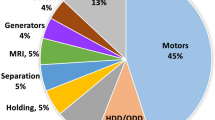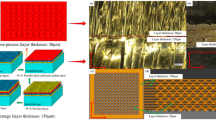Abstract
Magnetorheological finishing (MRF) is a computer-controlled deterministic polishing technique that is widely used in the production of high-quality optics. In order to overcome the defects of existing MRF processes that are unable to achieve concave surfaces with small radius of curvature, a configuration method of a novel structured MRF machine tool using small ball-end permanent-magnet polishing head is proposed in this paper. The preliminary design focuses on the structural configuration of the machine, which includes the machine body, motion units and accessory equipment, and so on. Structural deformation and fabrication accuracy of the machine are analyzed theoretically, in which the reasonable structure sizes, manufacturing errors and assembly errors of main structural components are given for configuration optimization. Based on the theoretical analysis, a four-axes linkage MRF machine tool is developed. Preliminary experiments of spot polishing are carried out and the results indicate that the proposed MRF process can achieve stable polishing area which meets requirement of deterministic polishing. A typical small-bore complex component is polished on the developed device and fine surface quality is obtained with sphericity of the finished spherical surfaces 1.3 µm and surface roughness Ra less than 0.018 µm.
Similar content being viewed by others
References
S. D. Jacobs, D. Golini, Y. Hsu, B. E. Puchebner, D. Strafford, W. I. Kordonski, I. V. Prokhorov, E. Fess, D. Pietrowski and V. W. Kordonski, Magnetorheological finishing: A deterministic process for optics manufacturing, Proceedings of SPIE, 2576 (1995) 372–382.
S. D. Jacobs, S. A. Arrasmith, I. A. Kozhinova, L. L. Gregg, A. B. Shorey, H. J. Romanofsky, D. Golini, W. I. Kordonski, P. Dumas and S. Hogan, An overview of magnetorheological finishing (MRF) for precision optics manufacturing, Ceramic Transactions, 102 (1999) 185–199.
W. I. Kordonski and S. D. Jacobs, Magnetorheological finishing, International Journal of Modern Physics B, 10 (23-24) (1996) 2837–2848.
S. R. Arrasmith, S. D. Jacobs, J. C. Lambropoulos, A. Maltsev, D. Golini and W. I. Kordonski, The use of magnetorheological finishing (MRF) to relieve residual stress and subsurface damage on lapped semiconductor silicon wafers, Proceedings of SPIE, 4451 (2001) 286–294.
W. I. Kordonski, S. D. Jacobs, D. Golini, E. Fess, D. Strafford, J. Ruckman and M. Bechtold, Vertical wheel magnetorheological finishing machine for flat, convex, and concave surfaces, Optical Fabrication and Testing Technical Digest Series, 7 (1996) 146–149.
J. E. DeGroote, H. J. Romanofsky, I. A. Kozhinova, J. M. Schoen and S. D. Jacobs, Polishing PMMA and other optical polymers with magnetorheological finishing, Proceedings of SPIE, 5180 (2003) 123–134.
A. Shorey, W. Kordonski and M. Tricard, Magnetorheological finishing of large and lightweight optics, Proceedings of SPIE, 5533 (2004) 99–107.
H. B. Cheng, Y. Yam and Y. T. Wang, Experimentation on MR fluid using a 2-axis wheel tool, Journal of Materials Processing Technology, 209 (12-13) (2009) 5254–5261.
D. C. Harris, History of Magnetorheological Finishing, Proceedings of SPIE, 8016 (2011) 1–22.
A. K. Singh, S. Jha and P. M. Pandey, Nanofinishing of a typical 3D ferromagnetic workpiece using ball end magnetorheological finishing process, International Journal of Machine Tools and Manufacture, 63 (2012) 21–31.
A. Sidpara and V. K. Jain, Nano-level finishing of single crystal silicon blank using magnetorheological finishing process, Tribology International, 47 (2012) 159–166.
A. Sidpara and V. K. Jain, Nanofinishing of freeform surfaces of prosthetic knee joint implant, Proceedings of the Institution of Mechanical Engineers Part B Journal of Engineering Manufacture, 226 (A11) (2012) 1833–1846.
A. Sidpara and V. K. Jain, Rheological properties and their correlation with surface finish quality in MR fluid-based finishing process, Machining Science and Technology, 18 (3) (2014) 367–385.
J. W. Lee, S. J. Ha, Y. K. Cho, K. B. Kim and M. W. Cho, Investigation of the polishing characteristics of metal materials and development of micro MR fluid jet polishing system for the ultra precision polishing of micro mold pattern, Journal of Mechanical Science and Technology, 29 (5) (2015) 2205–2211.
C. Song, Y. F. Dai and X. Q. Peng, Magnetorheological finishing of low-gradient curved surfaces based on four-axis linkage technique, Journal of Central South University, 20 (9) (2013) 2349–2358.
H. W. Park, Y. B. Park and S. Y. Liang, Multi-procedure design optimization and analysis of mesoscale machine tools, International Journal of Advanced Manufacturing Technology, 56 (1-4) (2011) 1–12.
B. S. Kim, S. K. Ro and J. K. Park, Development of a 3-axis desktop milling machine and a CNC system using advanced modern control algorithms, International Journal of Precision Engineering and Manufacturing, 11 (1) (2010) 39–47.
D. H. Huo, K. Cheng and F. Wardle, Design of a five-axis ultra-precision micro-milling machine-UltraMill. Part 2: integrated dynamic modelling, design optimisation and analysis, International Journal of Advanced Manufacturing Technology, 47 (9-12) (2010) 879–890.
L. Zhao, W. Y. Chen, J. F. Ma and Y. B. Yang, Structural bionic design and experimental verification of a machine tool column, Journal of Bionic Engineering, 5 (2008) 46–52.
X. Cheng, X. H. Yang, G. M. Zheng, Y. M. Huang and L. Li, Fabrication accuracy analysis of micromilling tools with complicated geometries by wire EDM, Journal of Mechanical Science and Technology, 28 (6) (2014) 2329–2335.
S. K. Cho, H. J. Kim and S. H. Chang, The application of polymer composites to the table-top machine tool components for higher stiffness and reduced weight, Composite Structures, 93 (2) (2011) 492–501.
Author information
Authors and Affiliations
Corresponding author
Additional information
Recommended by Associate Editor In-Ha Sung
Henan Liu received his M.S. in Mechanical Engineering from Harbin Institute of technology, China, in 2013. He is currently a Ph.D. candidate in Harbin Institute of technology, China. His research interest is magnetorheological finishing for precision optics manufacturing.
Mingjun Chen received his Ph.D. degree in Mechanical Engineering from Harbin Institute of technology, China, in 2001. He is currently a professor and Ph.D. candidate supervisor in Harbin Institute of technology, China. His research interests include precision and ultra-precision machining, micro machining and biomaterial compatibility evaluation.
Rights and permissions
About this article
Cite this article
Liu, H., Chen, M., Yu, B. et al. Configuration design and accuracy analysis of a novel magnetorheological finishing machine tool for concave surfaces with small radius of curvature. J Mech Sci Technol 30, 3301–3311 (2016). https://doi.org/10.1007/s12206-016-0639-y
Received:
Revised:
Accepted:
Published:
Issue Date:
DOI: https://doi.org/10.1007/s12206-016-0639-y




